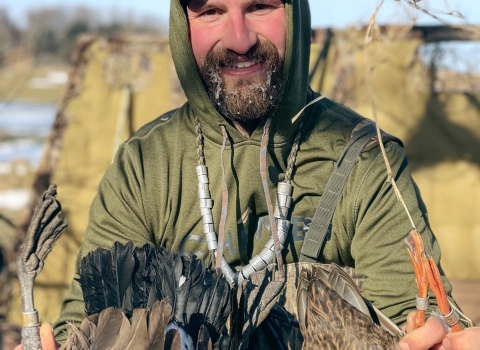Service works with Alabama landowner to turn trees into sand dunes on the Gulf Coast
By Denise Rowell, public affairs specialist, July 24, 2019
Fort Morgan, Alabama — Biologist Bill Lynn’s eyes widened as he saw the massive pile of Christmas trees before him. Lynn, a biologist with the U.S. Fish and Wildlife Service Alabama Field Office, was collecting leftover trees from businesses in Baldwin County. “If I had known the trees were this big, I would have grabbed more volunteers,” laughed Lynn.
Alabama Field Office biologists Erin Padgett and Bill Lynn pick up Christmas trees from a local business in Fort Morgan, Alabama. Photo by Denise Rowell, USFWS.
Although Christmas had come and gone, Lynn still had great use for these trees. He and his colleagues were hauling them to the beaches of Fort Morgan, where the trees would be used to create sand dunes. It’s an idea Lynn picked up from a colleague at Gulf State Park in Gulf Shores, Alabama. “Kelly Reetz is a naturalist at the park, and she used trees to restore nearly all of the sand dunes that were destroyed by Hurricanes Ivan and Katrina,” explained Lynn.
What is a sand dune?
A sand dune is a mount of sand usually formed by wind, and affected by the tide. They serve as habitat for many protected species, such as sea turtles, migratory birds and the Alabama beach mouse.
Landowners such as Tina Petrig have another use for the dunes; they serve as a first line of defense against a storm surge. Petrig owns property on Fort Morgan, and says she’s struggled with keeping sturdy dunes on her property. The Alabama Gulf coast is very prone to hurricanes, which makes it even more difficult to maintain them.
“Over the years, my dad would try fencing, which was a lot of expense and work for something that is likely to blow away in the next storm,” explained Petrig.
Planting vegetation such as sea oats and panic grass is another technique landowners use to stabilize sand dunes. But that comes with its own challenges. “We harvested some of the oat seeds and planted them on the Gulf front lots. But those took a long time to grow, and I was never certain our efforts had much to do with what vegetation did return after storms,” said Petrig.
Petrig was ready to give up on her sand dunes when she received a call from Bill Lynn, who approached her with the Christmas tree idea. “It seemed like such a simple and effective approach, yet one that I would not know how to properly do on my own,” said Petrig.
How does a tree become a dune?
Now that the trees were collected, it was time for Lynn and his co-workers to drag them through the sand, and place them strategically on Petrig’s property. They divided the trees into groups of three, placing them in the shape of the letter U.
“Trees should be clean and free of ornaments or tinsel. Set them in or near the existing vegetated dune areas of your property,” said Lynn. Two or three shovel full of sand should be tossed on each tree to help hold them in place,”
Dune design and accretion using Christmas trees. Graphic by Bill Lynn, USFWS.
With a slight sunburn on his face, Lynn pulled the final Christmas tree into place. Altogether, biologists placed 10 piles of three trees onto Petrig’s property. After taking a short break, volunteers dumped shovels of sand over each tree. The idea was to allow the branches to catch the wind-blown sand, and over time, create a dune.
Anchoring the sand
Assembling the Christmas trees was only the beginning of the dune project. The newly created dunes would also need a little help surviving a major weather event. Lynn says the best way to stabilize your dunes is to plant native vegetation in and around the tree area.
Planting sea oats over such a large area takes time and manpower. An active member of the Boy Scouts himself, Lynn found the perfect solution. He reached out to Boy Scout Troop 227 from Mobile, Alabama, for assistance. The scouts helped Lynn plant more than 1,000 sea oats, and other vegetation.
Tina Petrig’s property 16 months after placing the trees in the sand. Over time, the trees captured sand, creating dunes. Photo by Bill Lynn, USFWS.
“This stretch of beach on Fort Morgan will become a memorable spot as these boys grow and discover how unique an area like this is,” said assistant scoutmaster Hendrik Snow. “The scouts were happy to be a part of this effort.”
Beautiful dunes
It’s been more than a year since the trees were placed on Petrig’s property, and the dunes are forming nicely. The beach almost looks too good. She says trespassers commonly mistake her private property for a public beach.
For years, Tina Petrig wanted sand dunes on her property to help protect her home from storm surge. Thanks to Alabama Field Office biologist Bill Lynn and his Christmas trees, dunes are now forming nicely on her property. Photo by Bill Lynn, USFWS.
“I couldn’t be happier about what’s been done. I can also say that neighbors are very happy about the project and really appreciate having that patch of natural beach. Where there are dunes, there’s storm protection,” said Petrig. “We’re all hoping for a return of the sea turtles that had two nests on the property last year.”
Contact
Bill Lynn, fish and wildlife biologist
William_lynn@fws.gov, (251) 441-5868


